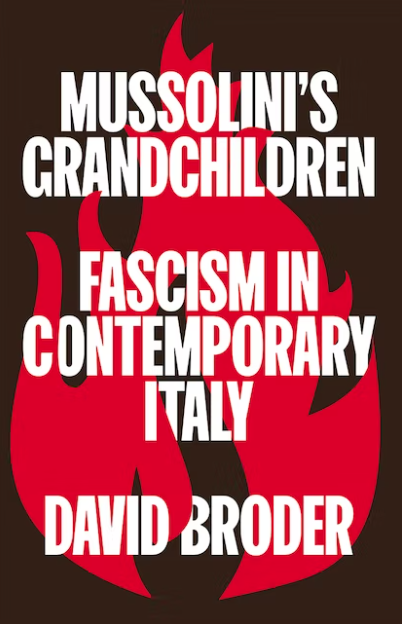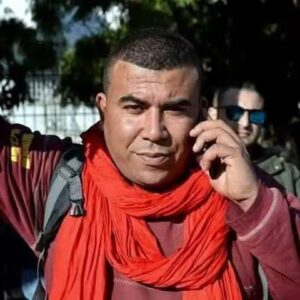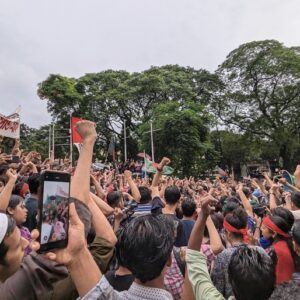Let’s start with the title. Writers can spend a lot of time working out a great title that sums up the key message of their book. The two-word title chosen by David Broder does precisely that. Children rarely turn out as carbon copies of their parents—as a parent, you have to learn that lesson pretty quickly. However, children also usually display solid, identifiable links to their parents. The exact balance between similarity and difference varies according to the family and the social and historical context in which the children grow up.
Ideological continuity with fascism in contemporary Italian politics
In Italy today, there is an ideological offensive led by the government but echoed in the media and among some opinion formers that the link between Mussolini’s fascist regime and today’s Fratelli d’Italia (Brothers of Italy), which leads the hard right government, has been definitively severed. At the same time, there are some people on the left who simplistically define the Meloni government as fascist, implying it is already fascist or is on the road to becoming one.
Broder’s book deconstructs and rejects both of these positions. He shows the threads of a certain ideological continuity with fascism: the defence of a Catholic, nationalist, and traditionalist family identity against the ‘replacement’ threat of foreign migrants, who are aided and abetted by the left, Marxists, and people like George Soros. He shows how this is a threat to democratic rights and divides the working class, making it more difficult to rebuild a struggle for a progressive or socialist alternative. However, the political project of Meloni is to develop a national conservative force along similar lines to Victor Orban’s party in Hungary or the Law and Justice party in Poland. Meloni is not about to organise fascist squads to attack leftists , dismantle the trade unions, ban political parties, or shut down free speech.
People on the left should take on board the distinction made by Broder that has already been used by some in the movement between post fascist currents like Fratelli d’Italia and the neo-fascist groups like Forza Nuova (New Force), which led anti-vaxers and others to attack the CGIL (main Italian trade union confederation) headquarters in Rome in 2021. The latter do have pretensions to setting up some sort of fascist regime and will use violence now and in the future to achieve it.
Implications for the left’s response to post fascist and neo fascist forces in Italy
The distinction is very important since it has implications for how the left responds to these forces. No platforming, i.e., preventing fascists from speaking and stopping their meetings, may in certain circumstances be appropriate against neo-fascists, particularly if their action is a direct physical threat to working people, such as migrant communities. Even in these cases, it is a tactical question depending on mass support rather than vanguard groups starting punch-ups. To apply the same method to people like Meloni or her party makes little sense and is counter-productive. Nobody serious on the left in Italy puts forward a no platform approach to the post-fascists.
This does not mean there should be no mass protests to highlight the oppressive policies of the most rightwing government we have seen since Mussolini. The leadership of the CGIL—yes, the same union federation that was attacked by neo-fascists—recently invited Prime Minister Meloni to their congress, arguing that prime ministers have been invited before. One thing is to allow post fascists to operate in normal institutional debate without violent confrontation; it is another thing to actually invite a post fascist to your trade union congress, which is supposed to be opposed to the government’s social and economic policies. Thankfully for the honour of the left, a small minority of delegates critical of the leadership organised a protest involving singing the partisan song Bella Ciao when Meloni went on stage and then walking out (only 30 or so delegates, unfortunately). These left-leaning delegates made a link between Meloni and her government’s refusal to actively save the seventy-odd migrants who drowned a week before the congress off the coast of Calabria. Soft toys symbolising the dead children were displayed or thrown.
Mussolini’s Children is exactly what activists need. It is not too long or written in academic language. There are enough footnotes to help keep the text uncluttered and allow those who are interested or specialists to follow up different trails. The introduction sets out a summary of the overall analysis, and the following chapters provide useful details and evidence for the analysis. The structure is chronological, with the final chapter dealing with the emergence of the Meloni government in September 2022. There is a timeline of events and a glossary of names, both of which are about the right size. Finally, there are some tables of the votes gained by the institutional fascists from the postwar period to today. The latter confirms that Meloni’s success is not entirely a surprise—the post fascists have been in government before and have had substantial parliamentary groups.
While the distinction between post fascists and neo fascists is important, this does not mean that there is a Chinese wall between the two currents. The neo fascist activist groups provide:
- electoral foot soldiers,
- Some candidates on the post fascist slate,
- muscle for stewarding at Fratelli d’Italia meetings and demonstrations
- help in the ideological battles to win hearts and minds over the defence of national identity against the antifascist tradition or sexual freedoms.
- Groups like CasaPound, in their cultural or ‘welfare’ work, can also reach parts of the electorate, like young people or the most deprived, that may not have looked to the traditional post fascist parties.
- Some are particularly active in mobilising the traditional Catholic pro-family supporters.
Broder shows how the breakup of the binary Christian Democrat/Communist Party political system with the end of the Cold War and the scandal of Tangetopoli (Bribesville) at the beginning of the 1990s led to new political formations led by populist outsiders like Berlusconi (Forzat Italia—a party of ‘smart’ businesspeople) and Bossi (Lega Nord—a northern separatist party). These new forces were quite happy to cuddle up to post fascist forces like the Alleanza Nazionale (National Alliance—a rebranding of the historic postwar MSI, Italian Social Movement). At one stage, Fini, who was probably the keenest of all the post fascists in wanting to dilute links with the past, actually merged the AN into one party with Berlusconi. Meloni and her mentor, La Russa, who are today in government, both held ministerial posts in a Berlusconi-led government.
There has been an ongoing recomposition of the right wing alliance for decades, with leading members and MPs passing from one formation to the next. So there is a porosity between the mainstream parties and the post fascists. These symbiotic relationships are mirrored in the way that the neo fascist groups relate to the Lega and Berlusconi in similar ways to how they work with the Fratelli d’Italia. So prominent neo fascists speak on the same electoral platforms as Lega and Forza Italia. Salvini, the current Lega leader, was happy to be photographed at the neo-fascist CasaPound events.
A recurring process is for the neo fascist leaders to be given roles such as management of the refuse services in the local councils controlled by forces like the Fratelli or the Lega. This happened in Rome and Verona, where these people ended up being charged with corruption, money laundering, and having links with criminal gangs.
The ongoing recomposition of the right-wing alliance and the rise of Giorgia Meloni.
Each of the emerging populist leaders on the right has seen their fortunes rise and fall. At first, Berlusconi was dominant, then Bossi and Salvini, and now it is the turn of Giorgia Meloni. As Broder points out in the final chapter, even Meloni’s success is not due to a huge advance in her support among new voting demographics but rather to a recomposition of support within the right wing coalition.
Her ‘breakthrough victory’ was helped by an increasingly large abstention rate adversely affecting the left and a divided opposition, which lost out in the undemocratic electoral system whose much diminished proportional element favours united electoral blocs. Of course, Meloni‘s decision to stay out of the Draghi government, which the Lega and Forza Italia both joined, helped raise her profile as the person standing up for the Italian people and its identity against the technocrats and political stitch-ups of the partocracy. Even this was electoral rhetoric since her government has aligned itself entirely with the economic policies of the Draghi government. Currently, she is even defending the EU-negotiated PNRR recovery plan against the backsliding of Salvini and some of her own MPs.
On the anniversary of the Fosse Aredeatine on 24 March this year, Meloni made a declaration about this Nazi massacre/reprisal that killed 335 anti-fascists and regretted the killing of ‘Italians’ by the Nazis. Such terminology might seem inconsequential to a non-Italian, but it goes to the heart of the post fascists’ attempts to eliminate the values of anti-fascism from Italian society and its memory. The Nazis did not just pick any Italians; they targeted anti-fascists, including some Jewish people. By using the term Italians, she is repeating the narrative where you talk only of Italians and war—who are soldiers or victims on every side, whether you are fighting with the resistance, in Mussolini’s army on the Eastern Front, or in the holdout Salo Republic established in the north after the September 43 armistice? Fascists and anti-fascists are put on the same footing, and no judgement is given on which side was right or not.
Just to show that this ‘pacification’ approach is not a one-off declaration, at the beginning of April this year, La Russa, speaker of the senate, the third highest public office, tried to ridicule one of the most well-known wartime partisan attacks by saying the Via Rasella operation did not actually kill any Nazis but rather a group of retired musicians. This caused an uproar with noisy TV debates. Since the historical record is undisputed, La Russa was forced to somewhat retract.
What it does show is that although Meloni and her government are not distinctly reflecting fascist economic or foreign policy, they are continuing the ideological battle to minimise, if not remove, anti-fascist values as the foundation of the Italian republic. Broder shows how the history of the foibe — when Yugoslav partisans killed Italians, many but not all of them fascists — influenced the reckonings that took place at the end of the war around the Trieste area. The post fascists and other right wingers try to make an equal comparison between these killings by ‘communists’ and the fascist repression. The state TV has broadcast dramas that have backed up this discourse, and one region has even produced a tendentious comic book to be used in schools. Anti fascists are accused of giving a totalitarian, one-sided view of the fascist period and the war. This campaign has been aided by the decline and crisis of the Italian Communist Party. Even some of their leaders, like ex-President Napolitano, have conceded to this ‘balancing’ of commemorations.
The other legs of the ideological counteroffensive are the defence of national identity against its destruction and ‘replacement’ by migrants and the need to support the traditional family against gay marriage, gay adoption, and so-called gender ideology. The migrant issue and the family are linked by alarmist demagogy about the decline in the Italian birthrate. Hence the incentives Meloni wants to give to families so women have more children.
The ideological battle to minimise anti fascist values as the foundation of the Italian republic.
Broder helps steer people away from exaggerated, alarmist positions about the new government while indicating the real present threats—how its economic policies continue to reduce workers’ living standards and how its ideological offensive makes it harder to get unity in struggle and advance a progressive project.
His focus in this book was on the post- and neo-fascists and their right wing allies, but the space they have been able to carve out for themselves is also fundamentally related to the failure of the whole left. Its defeats, starting in the 1980s after the huge gains made postwar and in the years following the hot autumn of 1969, have continued right up to today. Major sections of the radical left of the CP dissipated themselves in the violence of the Red Brigades. It was unable to hold on to its bastions in places like Fiat as the bosses restructuring and austerity offensive took off.
The big potential of Rifondazione Communista (Communist Refoundation), the left’s split from the CP, was seen for a few years, but it came to nothing on the rocks of its alliance policy with Prodi and other social liberals. Then Grillo’s 5 Star movement drew in many former left-leaning voters and activists into a confused neither left nor right populism that saw everything in terms of removing the political caste and having faith in the internet. The left is at its lowest ebb, with hardly any institutional representation. No wonder the post fascists are finding fertile ground.
Challenges for Giorgia Meloni and the need for the left to take an internationalist approach.
Having said all that, Melon’s position is not as solid as it seems, as Broder points out at the end. Salvini and Berlusconi both have their own projects and are keen to change the relationship of forces inside the right wing. If Meloni decides to push hard on projects like direct elections for the presidency or to totally remove the citizens income, she could come up against stronger opposition. Salvini is keen on the idea of differentiated autonomy for the regions, which would weaken national standards and wage contracts. Meloni’s party is traditionally more centralist.
In any case, the left has to fight back not just on these attacks and against austerity, but it also needs to firmly challenge the government’s cultural war. Just recently, in a European vote, the Italian government was the only one to refuse to condemn the new policies on LBGT+ rights. Broder emphasises how Meloni puts herself at the centre of an international, national conservative movement. The left needs to take a similar internationalist approach.
Art Book Review Books Campism Capitalism China Climate Emergency Conservative Government Conservative Party COVID-19 Creeping Fascism Economics EcoSocialism Elections Europe Far-Right Fascism Film Film Review Fourth International France Gaza History Imperialism Iran Israel Italy Keir Starmer Labour Party Long Read Marxism Marxist Theory Migrants Palestine pandemic Police Protest Russia Solidarity Statement Trade Unionism Ukraine United States of America War Women







